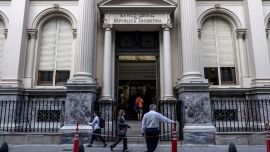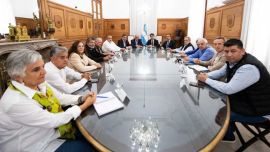Despite crisis and campaign President Mauricio Macri is due to attend the United Nations General Assembly in New York (which will be previewed in this column next weekend). Later the same week Finance Minister Hernán Lacunza will also be heading north for the 60th Assembly of the Inter-American Development Bank (BID, in its Spanish acronym) in Washington from September 26 to 28 – in many ways the ideal sequel to last Saturday’s World Bank as its regional counterpart.
This month’s Assembly will indeed mark the Diamond Jubilee of BID, which was founded on 8 April, 1959 (just 14 weeks after Fidel Castro took over in Cuba). President John F. Kennedy is often given the credit for kickstarting United States development initiatives in his first weeks in office in 1961 by creating the Peace Corps for the world and the Alliance for Progress for the region to promote democracy, economic growth and social justice in Latin America but the BID at least is evidence that such ideas were already around. Nevertheless, the concept was hatched by its beneficiaries – already floated at the First Pan-American Conference of 1890, the idea became reality when the Organisation of American States (OAS) approved the initiative of Juscelino Kubitshek, the creator of Brasilia. Since then the Inter-American Development Bank has been totally independent from the OAS and every other international organisation.
The world’s biggest regional development bank, with a working capital of US$105 billion and a payroll of 2,000 employees, the Inter-American Development Bank is unusually homogenous for an international organisation with only four official languages and four presidents over its six decades.
The Americas form a unique part of the world with nearly a billion people almost all speaking just four languages – English, French, Portuguese or Spanish. All four presidents have been Latin American to date – Chile’s Felipe Herrera (1960-1970), Mexico’s Antonio Ortiz Mena (1971-1988), Uruguay’s Enrique Iglesias (1988-2005), who did much to update the institution, and Colombia’s Philadelphia-born Luis Alberto Moreno since then. The latter has presided over a period in which social inclusion (especially educational inputs) has increasingly become the BID’s priority alongside infrastructural development, which in turn is sometimes questioned for its environmental impact (not least in recent days with the Amazon blaze amid worldwide concern over climate change).
This Inter-American bank has 48 shareholder members, which might lead the informed reader to ask how that works if there are only 35 countries in the Americas. The explanation is that only just over half the members receive the money while the rest supply it. When BID began in 1959, its 20 original members were indeed all American – the 10 South American republics, six Central American countries, Mexico and the US with nobody from a still largely colonised Caribbean, except Haiti and the Dominican Republic. But Washington soon tired of supporting the other 19 and sought to share the burden – Canada showed the way in 1972, to be followed by 13 European countries five years later. The BID’s most recent member is China, which entered in 2009 with an annual contribution of US$350 million as part of its increasingly voracious interest in this region. Of today’s 22 non-borrowing countries, all but the US and Canada are located outside the hemisphere in Western Europe and East Asia, while the borrowing members are now up to 26 with mostly Caribbean recruits. These borrowing countries control just over half the shares while the US holds 30 percent.
Since its creation the Inter-American Development Bank has provided development financing for Latin American countries at standard interest rates (protected by the Bank’s Triple A credit rating no matter what the lender’s country risk might be) in return for preferred creditor status. In the BID’s first two decades the region’s four biggest economies (Brazil, Mexico, Argentina and Venezuela) tended also to be the biggest lenders but this has changed since with Haiti a major recipient in recent years, the only country with its own BID department since the other four departments are clusters of nations – Central America (including Mexico), the Caribbean, the Andes and the Southern Cone (including Argentina).
Following this introductory thumbnail sketch, time to focus on the Argentine angle. There have been hundreds of projects over the years averaging an annual US$1.35 billion in this century with some US$9 billion in ongoing projects. These projects show that the BID is still a bank and still inter-American (or at least its borrowing members) but also that is no longer purely development in the traditional sense – around 60 percent is along the usual lines of transport, energy and rural development but half a dozen of the current 54 projects are for better governance while the rest pursue social aims (which may take physical form like the supply of running water but also include education and health services). The most recent BID credit (just six weeks ago) for US$360 million reflects this diversified agenda – US$300 million for provincial highways but US$60 million for digital technology.
A detailed shopping-list of all these projects past and present would defy the space of this column while its aid programmes generally lack the controversy on which journalism feeds. This is partly because these projects focus on inland provinces, true to the priority given to rural development from the BID’s origins in times of a largely agrarian and often semi-feudal Latin America. Thus the new governance programme (with special emphasis on replacing paperwork with digital technology) concentrates on provincial administrations – for the institution regional development also refers to regions within countries.
Indeed the one spot of recent controversy has arisen around the BID’s main venture in this capital – its new offices in the Villa 31 shantytown neighbourhood. The Bank sees this project as a win-win situation since it will include a bridge connecting Villa 31 with the rest of Recoleta while creating 500 to 1,000 jobs but shantytown residents argue that it will also mean numerous evictions while other critics would like to see this city’s neglected South Side favoured.
But in general the profile is low with a constant flow of funding in good times and bad – while suspense mounts over the tranche of US$5.4 billion now due from the International Monetary Fund, this assistance tends to be taken for granted. Unlike the other international organisations in this series, the relationship with BID seems immune to any change of government and there should be no reason to return to this subject.























Comments